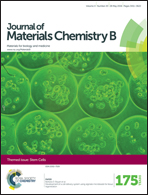Biomaterials for pluripotent stem cell engineering: from fate determination to vascularization
Abstract
Recent advancements in materials science and engineering may hold the key to overcoming reproducibility and scalability limitations currently hindering the clinical translation of stem cell therapies. Biomaterial assisted differentiation commitment of stem cells and modulation of their in vivo function could have a significant impact on stem cell-centred regenerative medicine approaches and next generation technological platforms. Synthetic biomaterials are of particular interest as they provide a consistent, chemically defined, and tunable way of mimicking the physical and chemical properties of the natural tissue or cell environment. Combining the emerging biomaterial and biofabrication advancements may finally give researchers the tools to modulate spatiotemporal complexity and engineer more hierarchically complex, physiologically relevant tissue mimics. In this review we highlight recent research advancements in biomaterial assisted pluripotent stem cell (PSC) expansion and three dimensional (3D) tissue formation strategies. Furthermore, since vascularization is a major challenge affecting the in vivo function of engineered tissues, we discuss recent developments in vascularization strategies and assess their ability to produce perfusable and functional vasculature that can be integrated with the host tissue.

- This article is part of the themed collection: Stem Cells

 Please wait while we load your content...
Please wait while we load your content...